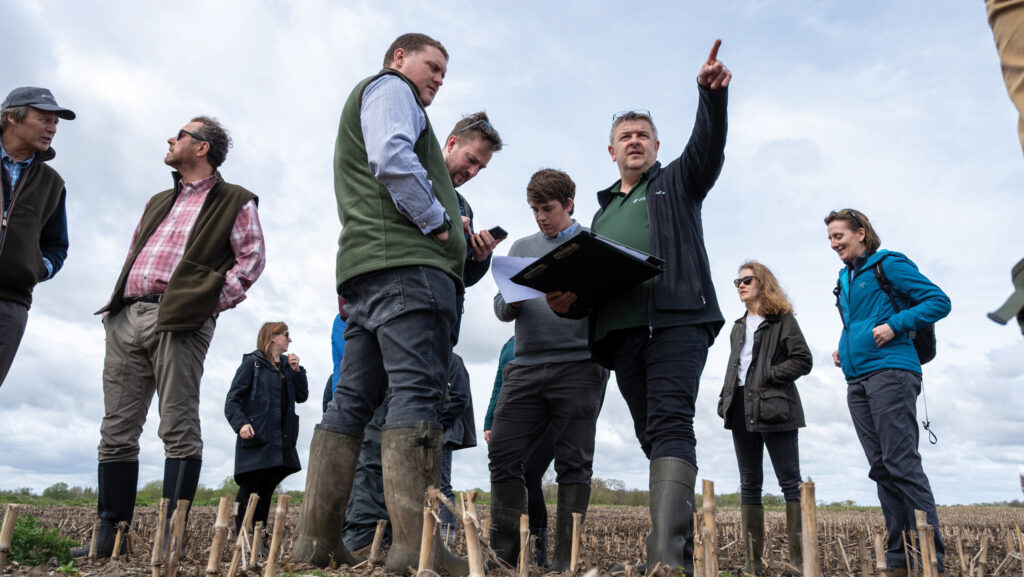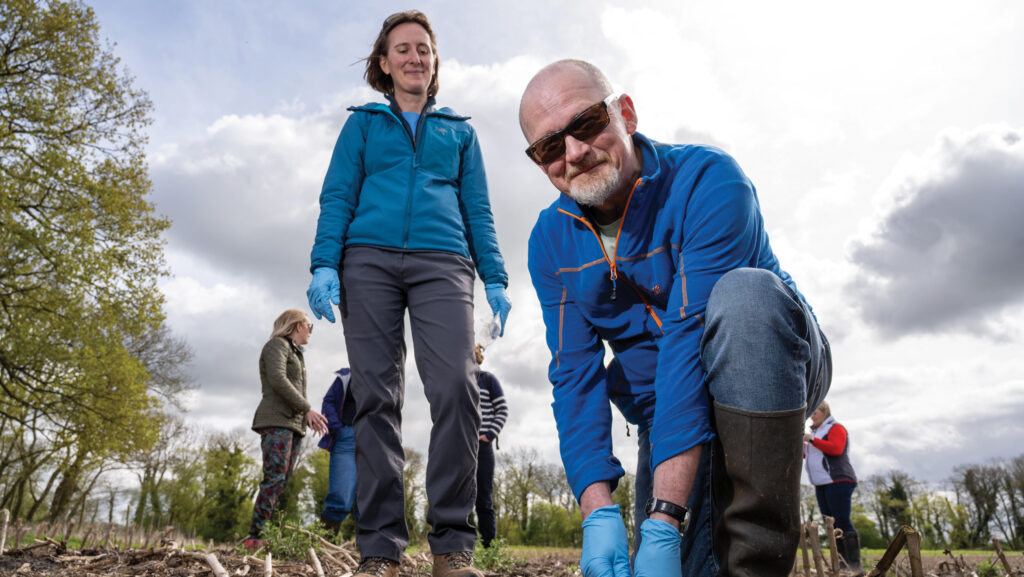How farms are generating income from the environment
 © Matthew Power Photography
© Matthew Power Photography Flood-prone land in west Norfolk that is difficult to farm productively is being turned into wetland – thanks to a mix of public funding and private investment.
Using “blended finance” to fund environmental improvements is becoming increasingly attractive to a growing number of farmers looking to replace lost income as the Basic Payment Scheme phase-out continues in England.
See more: How to bounce back from bad weather and drop in farm support
The Stoke Ferry wetland creation project involves almost 120ha of challenging arable peat soil adjacent to the River Wissey, 6.5 miles south-east of Downham Market.
“It’s quite difficult to farm consistently,” says Mike Edwards, director of Albanwise Environment, a sister company to Albanwise Farming, which is managed by Transition farmer Duncan Blyth at nearby Barton Bendish.
“It’s been problematic over the years so we’re turning it into a wetland creation project.”
The goal for Albanwise Environment is to drive nature recovery, generating revenue streams from the sale of biodiversity units, carbon credits, nutrient credits and providing increased access and recreation.
Similar projects were a hot topic at this month’s Norfolk Landscapes Conference, a one-day event and exhibition which brought together more than 380 farmers, land managers and environmental experts.
The Stoke Ferry initiative is one of the latest examples of landscape recovery or nature restoration being undertaken using blended finance.
In this case a mix of agri-environment funding and corporate investment.

© Matthew Power Photography
Funding sources
A Nature for Climate Peatland Restoration Grant has been secured to cover some of the project’s initial capital costs.
This includes raising river levels, establishing wetland vegetation and securing fencing for grazing.
This has involved the intervention of blocking ditches in targeted locations, effectively rewetting the peat, limiting its oxidisation and protecting the site’s carbon store.
Given the scale of land-use change involved, Mike Edwards says Albanwise also wanted to secure long-term support for the project.
Although in a landscape recovery scheme, having a strong corporate partner too is a bonus, he explains.
That corporate partner is UK law firm Mills & Reeve.
Part-funding the project helps meet the company’s environmental, social and governance objectives, says Mills & Reeve head of sustainability Jessica Wilkes-Ball.
“We wanted to identify a project that gave us the opportunity to give back to the community and nature,” she says.
“We really see the value in nature restoration, biodiversity net gain and nature recovery.”
In a first step towards site restoration, environmental DNA (eDNA) specialists NatureMetrics have extracted genetic traces of the land from soil samples to detect which species live in and around the area.
Soil samples
These soil samples will be compared in global reference libraries that contain the genomes of thousands of species, helping to identify where the land needs to be improved.
The eDNA will also be compared with samples taken from nearby wetland sites to provide clues as to the sort of habitats and landscapes that could develop at Stoke Ferry.
More investment is required to cover remaining establishment costs and site management.
“Then we can realise the potential benefits and create a new space for nature that lasts for generations,” says Mike Edwards.
The establishment of wetland habitats, including reedbed and fen, will support biodiversity.
In time, this will sequester carbon back out of the atmosphere.
For investors, Stoke Ferry could be used for biodiversity net gain or to offset operational carbon emissions.
With all baseline data captured, the project’s benefits can be measured and verified, says Albanwise.
New skills needed to access ‘green finance’
A roadmap outlining ways to generate revenue by improving the environment could benefit farmers across the country.
The study details the environmental land management skills farmers need to implement successful measures that improve soil health, generate cleaner air and water, help mitigate climate change and reverse biodiversity loss.
It also recommends ways to achieve these skills, including joining or forming a farm cluster.
These are groups of like-minded farmers who share their knowledge of what works and what doesn’t when it comes to environmental management.
The Norfolk Skills Gap Analysis study focuses on the potential for farmers to generate environmental income in the East of England.
But the report’s authors say the findings and recommendations apply to farmers elsewhere in the UK too.
The big lesson for farmers is to go out and learn as much as you can, says report co-author Michael Mack, of Anglia Rural Consultants.
This means seeking good advice and measuring your existing environmental assets.
Independent advice
“As a farm business you need independent advice that gives you clarity– advice that isn’t trying to influence you one way or the other – to achieve the best environmental improvement in the most sustainable way.”
The report was launched at the Norfolk Landscapes Conference.
Home to some of England’s largest rural estates, the county is seen as being at the forefront of landscape-scale management.
But cluster groups are enabling smaller farmers elsewhere to unlock landscape-based revenue too.
Environmental skills are vital for the successful implementation of land-management schemes, says the document.
They ensure that any chosen options are sustainable and effective in conserving natural resources and biodiversity.
Changing weather patterns are creating unpredictable growing seasons and increasing the likelihood of floods and droughts, says Clarke Willis, of the Norfolk Farming and Wildlife Advisory Group (FWAG), which commissioned the report.
“Land management in Britain is becoming ever more challenging and complex.
“Farmers must navigate a transition to make their businesses sustainable, utilising various public and private funding streams.”
Farm income
As the Basic Payment Scheme (BPS) phase-out continues, public and private environmental schemes are generating an increasing proportion of income on many farms.
Yet on others, they remain an untapped revenue source.
The Sustainable Farming Initiative (SFI) is a key component of the government’s Environmental Land Management (ELM) scheme for England.
Other public-funded schemes include Countryside Stewardship and Landscape Recovery.
BPS payments are now half what they were just a few years ago, leaving a substantial hole in farm incomes.
Although the SFI can help plug that gap, other revenue generating opportunities are available too.
Multinational food and drink corporations are launching their own bespoke initiatives.
These encourage their farmer-suppliers to embrace measures that meet their corporate environmental, social and governance objectives.
They include Nestlé’s Landscape Enterprise Networks scheme, McCain’s Smart and Sustainable Farming initiative for regenerative potato production, and the M&S Farm of the Future network.
Farms join forces to deliver eco-system services
Almost 600 farmers have now joined forces to deliver eco-system services on a landscape scale – while receiving a fair income in return.
The farmer-owned, farmer-led Environmental Farmers Group provides natural capital investors with a single point of contact and helps farmers receive fair reward for delivering nature recovery and climate change mitigation.
Founded in 2022, the first EFG cluster group brought farmers together across 2,500ha of the Avon catchment in Hampshire and Wiltshire.
Other groups have since been formed, including in the Midlands and north Lincolnshire.
EFG members get access to trading opportunities in natural capital markets, guidance on how to trade, and benefit from farmer buying power in those natural capital markets.
Farmers pay a fee of £1.25/ha.
When a natural capital deal is struck, the farmer on whose land the trade is based receives 88% of the value, with 9% shared equally among other farmers in the group, and 3% going on overheads.
The EFG’s 560 members and registered expressions of interest encompass some 267,000ha – equivalent to 6% of England’s farmed area.
It has built a £25m trading funnel and further agreements are in the pipeline.
3 main environmental markets
- Carbon – selling carbon credits to buyers wanting to offset greenhouse gas emissions
- Biodiversity – including Biodiversity Net Gain (BNG) to developers legally bound to deliver a 10% improvement
- Nutrients – selling eco-system services typically to water companies or developers to reduce nutrient runoff into rivers or streams.
Source: NFU
